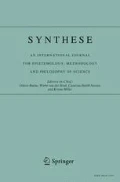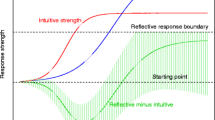Abstract
A two-systems model of moral judgment proposed by Joshua Greene holds that deontological moral judgments (those based on simple rules concerning action) are often primary and intuitive, and these intuitive judgments must be overridden by reflection in order to yield utilitarian (consequence-based) responses. For example, one dilemma asks whether it is right to push a man onto a track in order to stop a trolley that is heading for five others. Those who favor pushing, the utilitarian response, usually take longer to respond than those who oppose pushing. Greene’s model assumes an asymmetry between the processes leading to different responses. We consider an alternative model based on the assumption of symmetric conflict between two response tendencies. By this model, moral dilemmas differ in the “difficulty” of giving a utilitarian response and subjects differ in the “ability” (tendency) to give such responses. (We could just as easily define ability in terms of deontological responses, as the model treats the responses symmetrically.) We thus make an analogy between moral dilemmas and tests of cognitive ability, and we apply the Rasch model, developed for the latter, to estimate the ability-difficulty difference for each dilemma for each subject. We apply this approach to five data sets collected for other purposes by three of the co-authors. Response time (RT), including yes and no responses, is longest when difficulty and ability match, because the subject is indifferent between the two responses, which also have the same RT at this point. When we consider yes/no responses, RT is longest when the model predicts that the response is improbable. Subjects with low ability take longer on the “easier” dilemmas, and vice versa.
Similar content being viewed by others
References
Baayen, R. H. (2009). languageR: Data sets and functions with “Analyzing Linguistic Data: A practical introduction to statistics”. R package version 1.2.
Baayen R. H., Davidson D. J., Bates D. M. (2008) Mixed-effects modeling with crossed random effects for subjects and items. Journal of Memory and Language 59: 390–412
Baron J. (2011) Utilitarian emotions: Suggestions from introspection. Emotion Review (special issue on “Morality and emotion” edited by Joshua Greene) 3: 286–287
Baron, J., & Ritov, I. (2009). Protected values and omission bias as deontological judgments. In D. M. Bartels, C. W. Bauman, L. J. Skitka & D. L. Medin (Eds.), Moral judgment and decision making, Vol. 50 in B. H. Ross (series editor), The psychology of learning and motivation (pp. 133–167). San Diego, CA: Academic Press.
Bates D. M. (2005) Fitting linear mixed models in R. R News 5: 27–30
Bates, D., Maechler, M., & Bolker, B. (2011). lme4: Linear mixed-effects models using S4 classes. R package version 0.999375-42. http://CRAN.R-project.org/package=lme4.
Busemeyer J. R., Townsend J. T. (1993) Decision Field Theory: A dynamic cognition approach to decision making. Psychological Review 100: 432–459
Epstein S. (1994) Integration of the cognitive and psychodynamic unconscious. American Psychologist 49: 709–724
Finucane M. L., Alhakami A., Slovic P., Johnson S. M. (2000) The affect heuristic in judgments of risks and benefits. Journal of Behavioral Decision Making 13: 1–17
Frederick S. (2005) Cognitive reflection and decision making. Journal of Economic Perspectives 19: 25–42
Greene J. (2005) Cognitive neuroscience and the structure of the moral mind. In: Laurence S., Carruthers P., Stich S. (eds) The innate mind: Structure and contents. Oxford University Press, New York, pp 338–352
Greene J. D. (2009) Dual-process morality and the personal/impersonal distinction: A reply to McGuire, Langdon, Coltheart, and Mackenzie. Journal of Experimental Social Psychology 45: 581–584
Greene J., Haidt J. (2002) How (and where) does moral judgment work?. Trends in Cognitive Sciences 6: 517–523
Greene J. D., Sommerville R. B., Nystrom L. E., Darley J. M., Cohen J. D. (2001) An fMRI investigation of emotional engagement in moral judgment. Science 293: 2105–2108
Greene J. D., Nystrom L. E., Engell A. D., Darley J. M., Cohen J. D. (2004) The neural bases of cognitive conflict and control in moral judgment. Neuron 44: 389–400
Greene J. D., Morelli S. A., Lowenberg K., Nystrom L. E., Cohen J. D. (2008) Cognitive load selectively interferes with utilitarian moral judgment. Cognition 107: 1144–1154
Greene J. D., Cushman F. A., Stewart L. E., Lowenberg K., Nystrom L. E., Cohen J. D. (2009) Pushing moral buttons: The interaction between personal force and intention in moral judgment. Cognition 111: 364–371
Hammond K. R. (1996) Human judgment and social policy: Irreducible uncertainty, inevitable error, unavoidable injustice. Oxford University Press, New York
Kahneman D., Frederick S. (2002) Representativeness revisited: Attribute substitution in intuitive judgment. In: Gilovich T., Griffin D., Kahneman D. (eds) Heuristics and biases: The psychology of intuitive judgment. Cambridge University Press, New York, pp 49–81
Link S. W. (1992) The wave theory of difference and similarity. Psychology Press, Cambridge, MA
Lord F. M., Novick M. R. (1968) Statistical theories of mental test scores. Addison-Wesley, Reading, MA
Moore A. B., Clark B. A., Kane M. J. (2008) Who shalt not kill? Individual differences in working memory capacity, executive control, and moral judgment. Psychological Science 19: 549–557
Moore A. B., Lee N. Y. L., Clark B. A. M., Conway A. R. A. (2011) In defense of the personal/impersonal distinction in moral psychology research: Cross-cultural validation of the dual process model of moral judgment. Judgment and Decision Making 6: 186–195
Petrusic W. F., Jamieson D. G. (1978) Relation between probability of preferential choice and time to choose changes with practice. Journal of Experimental Psychology: Human Perception and Performance 4: 471–482
R Development Core Team. (2011). R: A language and environment for statistical computing. Vienna: R Foundation for Statistical Computing. http://www.R-project.org.
Rasch, G. (1961). On general laws and the meaning of measurement in psychology. In Proceedings of the Fourth Berkeley Symposium on Mathematical Statistics and Probability (Vol. IV, pp. 321–334). Berkeley, CA: University of California Press.
Ratcliff R., McKoon G. (2008) The diffusion decision model: Theory and data for two-choice decision tasks. Neural Computation 20: 873–922
Rizopoulos, D. (2006). ltm: An R package for Latent Variable Modelling and Item Response Theory Analyses. Journal of Statistical Software, 17, 1–25. URL http://www.jstatsoft.org/v17/i05/.
Sloman S. A. (1996) The empirical case for two systems of reasoning. Psychological Bulletin 119: 3–22
Spranca M., Minsk E., Baron J. (1991) Omission and commission in judgmentand choice. Journal of Experimental Social Psychology 27: 76–105
Stanovich K. E., West R. F. (2002) Individual differences in reasoning: Implications for the rationality debate?. In: Gilovich T., Griffin D., Kahneman D. (eds) Heuristics and biases: The psychology of intuitive judgment. Cambridge University Press, New York, pp 421–440
Starcke, K., Ludwig, A.-C., & Brand, M. (forthcoming). Anticipatory stress interferes with utilitarian moral judgment. Judgment and Decision Making.
Author information
Authors and Affiliations
Corresponding author
Rights and permissions
About this article
Cite this article
Baron, J., Gürçay, B., Moore, A.B. et al. Use of a Rasch model to predict response times to utilitarian moral dilemmas. Synthese 189 (Suppl 1), 107–117 (2012). https://doi.org/10.1007/s11229-012-0121-z
Received:
Accepted:
Published:
Issue Date:
DOI: https://doi.org/10.1007/s11229-012-0121-z




